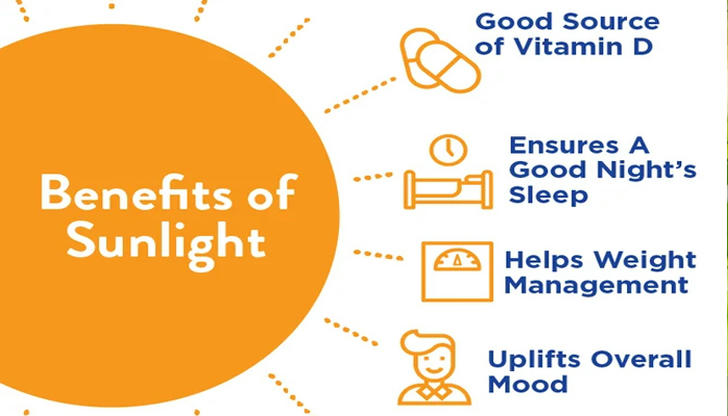Harnessing the Power of Sunlight: Vitamin D Benefits and Safe Sun Exposure Tips

The Importance of Sunlight for Health
Sunlight is more than just a natural source of light—it is an essential component of our overall well-being. Among its many benefits, sunlight plays a crucial role in the production of Vitamin D, which is vital for numerous bodily functions. Despite the numerous benefits sunlight provides, it’s important to approach sun exposure with caution, as excessive sun exposure can lead to harmful effects like skin damage and an increased risk of skin cancer. In this article, we'll explore the benefits of Vitamin D, how it is produced in the body through sun exposure, and the importance of balancing sun exposure to gain its benefits while protecting your skin.
What is Vitamin D and Why is it Important?
Vitamin D is a fat-soluble vitamin that plays an essential role in a variety of functions within the body. Often referred to as the "sunshine vitamin," Vitamin D is produced when the skin is exposed to ultraviolet B (UVB) rays from the sun. It is important for several reasons:
Bone Health: Vitamin D aids in the absorption of calcium and phosphorus from the digestive system, which are essential for strong, healthy bones. A deficiency in Vitamin D can lead to bone diseases such as rickets in children and osteoporosis in adults.
Immune System Support: Vitamin D plays a critical role in regulating the immune system. Adequate levels of Vitamin D can help strengthen your immune defenses, reducing the risk of infections like the flu, colds, and respiratory illnesses.
Mental Health and Mood Regulation: There is growing evidence suggesting that Vitamin D has a direct effect on mood. Inadequate levels of Vitamin D have been linked to increased risks of depression, anxiety, and seasonal affective disorder (SAD). Sunlight exposure is thought to help boost serotonin levels in the brain, promoting feelings of well-being.
The Science Behind Sun Exposure and Vitamin D Production
When UVB rays from sunlight hit the skin, they are absorbed by a substance called 7-dehydrocholesterol in the skin, which is then converted into Vitamin D3 (cholecalciferol). This vitamin is later converted into its active form in the liver and kidneys.

However, several factors can affect the amount of Vitamin D produced through sun exposure:
Skin Type: People with lighter skin produce Vitamin D more efficiently than those with darker skin because they have less melanin, which can block UVB rays.
Time of Day: Sun exposure during midday (10 a.m. to 4 p.m.) produces more Vitamin D than exposure at other times of the day. UVB rays are stronger during these hours.
Geographic Location: People living closer to the equator generally have greater access to UVB rays throughout the year, while individuals in northern latitudes may struggle to produce sufficient Vitamin D, especially during the winter months.
Season: Vitamin D production is highest during the summer months when the sun is stronger, while it decreases in the winter due to lower UVB intensity.
The Benefits of Adequate Vitamin D Levels
Getting enough Vitamin D can have a positive impact on many aspects of health, including:
1. Supports Bone Health
Vitamin D is critical for the absorption of calcium, which is vital for strong, healthy bones. Without enough Vitamin D, your body cannot absorb enough calcium, which can lead to brittle bones, fractures, and conditions such as rickets in children and osteomalacia or osteoporosis in adults. Ensuring adequate Vitamin D levels helps maintain bone density and strength, reducing the risk of bone fractures, particularly as we age.
2. Enhances Immune Function
A healthy immune system is crucial for defending the body against infections. Vitamin D enhances the pathogen-fighting effects of immune cells, such as macrophages and dendritic cells. Studies suggest that adequate Vitamin D levels can reduce the risk of chronic diseases and infections, such as the flu, colds, and respiratory illnesses.
3. Improves Mood and Mental Health

One of the most compelling benefits of Vitamin D is its positive influence on mood. Sunlight exposure is known to stimulate the production of serotonin, a neurotransmitter that helps regulate mood, anxiety, and happiness. Adequate Vitamin D levels are associated with reduced symptoms of depression and seasonal affective disorder (SAD), a type of depression that occurs in the winter months when sunlight exposure is limited.
4. Supports Muscle Strength
Vitamin D also plays a role in maintaining muscle strength. Adequate Vitamin D levels help improve muscle function, especially in older adults, where low Vitamin D levels are associated with muscle weakness, falls, and an increased risk of fractures. Maintaining optimal Vitamin D levels supports overall mobility and strength.
Safe Sun Exposure: Balancing Benefits and Risks
While moderate sun exposure is essential for Vitamin D production, excessive sun exposure carries risks, including skin damage, premature aging, and an increased risk of skin cancer. Therefore, it is important to practice safe sun exposure to maximize benefits and minimize risks.
Tips for Safe Sun Exposure
1. Limit Time in the Sun
It’s important to strike a balance when it comes to sun exposure. Around 10 to 30 minutes of sun exposure a few times a week is often enough for the body to produce sufficient Vitamin D. The exact time depends on your skin type, geographical location, and the intensity of the sun. People with darker skin may need more time to produce the same amount of Vitamin D.
2. Use Sunscreen
While some sun exposure is important, protecting your skin from the harmful effects of UV radiation is essential. Apply a broad-spectrum sunscreen with SPF 30 or higher to exposed skin. Make sure to reapply every two hours, or more frequently if swimming or sweating.
3. Wear Protective Clothing
If you're going to be in the sun for extended periods, wear protective clothing, including a wide-brimmed hat, sunglasses, and long-sleeved shirts to reduce the risk of skin damage.
4. Avoid Peak Sun Hours
The sun’s rays are strongest between 10 a.m. and 4 p.m. Try to limit your exposure during these hours. If you do need to be outside, seek shade whenever possible.
5. Know Your Skin Type
People with fair skin, light eyes, and red or blonde hair are more susceptible to skin damage from UV radiation. Those with darker skin produce more melanin, which offers some natural protection against UV rays. Knowing your skin type will help you understand how much sun exposure is safe for you.
Getting Vitamin D from Other Sources
While sunlight is the best natural source of Vitamin D, there are other ways to ensure you're getting enough:

Dietary Sources: Include foods rich in Vitamin D in your diet, such as fatty fish (salmon, mackerel), fortified foods (milk, cereal, orange juice), egg yolks, and mushrooms exposed to UV light.
Supplements: Vitamin D supplements are an option for people who cannot get enough from sunlight or their diet. Vitamin D3 (cholecalciferol) is generally the most effective supplement form.
When to See a Doctor
If you experience symptoms of Vitamin D deficiency, such as fatigue, bone pain, muscle weakness, or frequent infections, consult a healthcare provider. They may recommend a blood test to check your Vitamin D levels and advise on appropriate supplementation or dietary changes.
Conclusion: Enjoying Sunlight Safely for Optimal Health
Vitamin D plays an essential role in maintaining strong bones, supporting immune function, improving mood, and enhancing muscle strength. Sunlight is the most natural and effective way for your body to produce Vitamin D, but it’s important to balance sun exposure with proper protection to avoid skin damage. By following safe sun exposure practices, getting enough Vitamin D from dietary sources, and considering supplements when necessary, you can harness the power of sunlight to boost your health. Always consult a healthcare provider if you have concerns about your Vitamin D levels or sun exposure.
